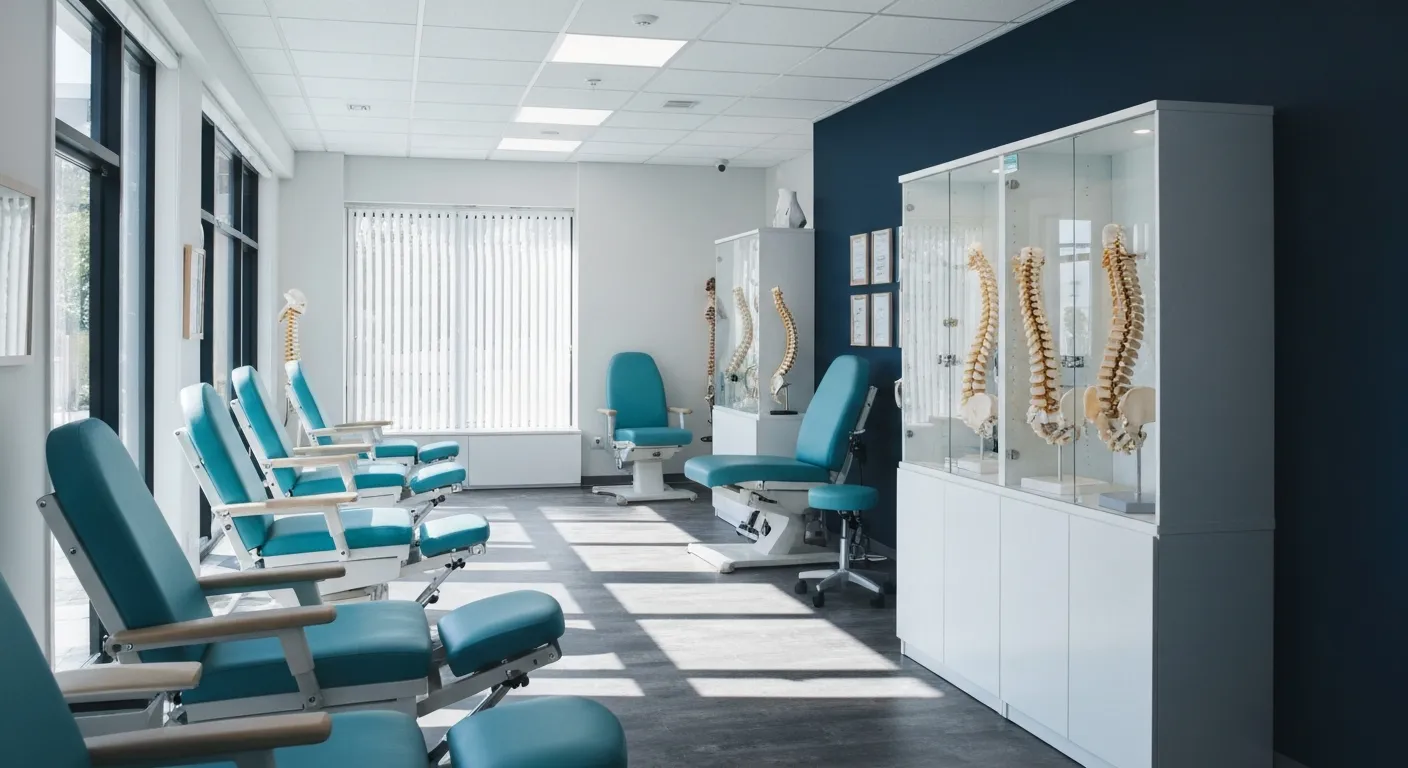Preparing for Your First Chiropractic Appointment with Confidence
October 23, 2025
10 min

Confidently Navigating Your Initial Chiropractic Appointment
Visiting a chiropractor for the first time can bring questions and anticipation. Understanding what to expect and how to prepare can make your initial chiropractic appointment a positive and productive experience. From gathering necessary documents to knowing the examination process and what follows, this guide provides you with clear insights and practical tips to help you prepare confidently and benefit fully from your care.
Understanding Chiropractic Care: What It Is and How It Works

What is chiropractic care and what does it treat?
Chiropractic care is a holistic health practice that focuses on diagnosing and treating disorders related to the musculoskeletal system. This system includes bones, muscles, joints, tendons, and connective tissues. Chiropractors use natural, non-invasive, drug-free, and non-surgical treatments to improve the function and alignment of the spine and extremity joints. Learn more about chiropractic care benefits.
Scope of chiropractic practice
Chiropractors specialize in restoring joint function and range of motion, aiming to relieve pain and enhance overall mobility. Their work involves hands-on adjustments and spinal manipulation techniques that may produce familiar popping or cracking sounds. These sounds result from the release of gas bubbles in joint spaces and are normal during treatment. See details about chiropractic adjustment sounds.
Holistic and non-invasive treatment approach
Chiropractic care treats the body as a whole, addressing the root causes of pain rather than merely masking symptoms. It encourages the body's own healing abilities and seeks to reduce the need for surgery or reliance on medications. Treatments can involve spinal adjustments along with supporting therapies such as massage, electrical stimulation, and lifestyle advice. Explore more on the holistic chiropractic approach.
Focus on the musculoskeletal system
The core focus remains on the musculoskeletal system, especially the spine, which protects the nervous system and plays a vital role in overall health. Correcting spinal misalignments can impact nervous system function, helping alleviate issues like tension headaches, back and neck pain, and muscle tightness. Read about spinal manipulation and musculoskeletal health.
Common conditions treated
Chiropractors commonly treat ailments such as lower back pain, neck pain, headaches, sciatica, sports injuries, and soft tissue problems. They also play a role in rehabilitation after accidents or strokes by helping to rebuild strength and mobility. More information on conditions treated by chiropractors is available.
Through its comprehensive, natural approach, chiropractic care helps improve joint health, reduce discomfort, and promote better quality of life without invasive procedures. For a detailed overview, visit What to Expect at Your First Chiropractic Appointment.
Preparing for Your Appointment: Practical Tips for a Smooth Visit
What should I bring to my first chiropractic appointment?
Come prepared with your medical records, insurance cards, and photo identification. Also, bring a list of any medications you are taking and recent imaging reports like X-rays or MRIs if you have them. These help the chiropractor understand your health background and tailor your care.
Why arrive early and how does paperwork help?
Plan to arrive 10 to 15 minutes before your scheduled time. This allows you to complete intake forms covering your medical history, symptoms, and lifestyle. Proper paperwork speeds up your appointment and gives the chiropractor vital information to assess your condition.
What type of clothing should I wear?
Choose loose-fitting, comfortable clothing that allows easy movement. Stretchable apparel facilitates a thorough examination and lets the chiropractor perform adjustments or diagnostic tests without restriction. Wearing comfortable clothing is recommended.
Should I eat or drink before my visit?
Eating a light, protein-rich meal several hours before your appointment can help keep your blood sugar stable and improve comfort while lying on the adjustment table. Staying hydrated with water or electrolyte drinks supports healthy muscles and joints during and after treatment. See tips on eating and hydration before chiropractic care.
How to prepare notes about your symptoms and health history?
Be ready to describe your pain or discomfort clearly. Note the location, intensity, duration, and any triggers or relieving factors. Also, mention any previous treatments or injuries. This detailed information assists your chiropractor in identifying problem areas and creating an effective treatment plan. Learn more about communicating symptoms to your chiropractor.
| Preparation Step | Details | Why It Matters |
|---|---|---|
| Items to Bring | Medical records, insurance, ID, medications | Informs the chiropractor’s evaluation |
| Arriving Early | 10-15 minutes before appointment | Allows time for paperwork and reduces stress |
| Clothing | Loose, stretchable, comfortable | Facilitates examination and treatment |
| Eating and Hydration | Light meal and hydration before visit | Maintains comfort and supports muscle health |
| Symptom & Health Notes | Clear details on pain and medical history | Helps tailor accurate diagnosis and care |
What to Expect During Your First Chiropractic Examination

Initial consultation and medical history review
Your first chiropractic appointment begins with a detailed consultation. You'll discuss your health concerns, pain history, and lifestyle habits. This conversation helps the chiropractor understand potential causes of your discomfort and set appropriate treatment goals. For more about this, see First chiropractic consultation overview and Questions to Ask a Chiropractor.
Physical examination components
The chiropractor then conducts a physical exam. This includes checking your posture for imbalances like high shoulders or uneven hips. Muscle tone and strength are assessed to identify areas of tension or weakness. Learn more in Physical examination in chiropractic consultation and Chiropractic physical exams and tests.
Range of motion and posture assessment
Assessment of your range of motion tests how far your joints and spine move in different directions. Posture analysis identifies misalignments or irregular spinal curves contributing to pain. See Posture analysis benefits and Range of motion testing.
Neurological and orthopedic tests
Neurological tests evaluate your reflexes and nerve function to detect any nerve irritation or compression. Orthopedic tests involve specific movements designed to locate the source of musculoskeletal issues. Details can be found at Neurological and orthopedic tests in chiropractic exam and Orthopedic tests for diagnosis.
Use of diagnostic imaging like X-rays or MRIs
In some cases, the chiropractor may order X-rays or MRIs. These imaging tools provide insight into spinal alignment or soft tissue conditions. However, imaging is used judiciously to avoid unnecessary radiation exposure. Learn about X-rays in chiropractic visit and Diagnostic Tests in Chiropractic (X-rays, MRI).
Safety protocols in diagnosis
Licensed chiropractors follow strict safety protocols during diagnosis, ensuring all tests and imaging are medically justified. This careful approach helps protect your health while allowing effective treatment planning. See more at Is Chiropractic Care Safe? and Chiropractic Licensing Requirements.
Answer to “What happens during the initial chiropractic exam?”
Your first visit includes a thorough medical history review and physical examination evaluating posture, muscle tone, neurological function, and range of motion. Specialized orthopedic and neurological tests pinpoint dysfunctions. Diagnostic imaging like X-rays or MRIs may be employed selectively. Together, these steps provide a comprehensive understanding that guides your customized treatment plan. For a full overview, refer to What to Expect at Your First Chiropractic Visit and First Chiropractic Appointment Preparation.
The Chiropractic Adjustment: What You Should Know

What is a chiropractic adjustment and what does it feel like?
A chiropractic adjustment, also called spinal manipulation, is a procedure where a chiropractor applies controlled and precise force to specific spinal joints or other joints in the body. The goal is to improve the joint's range of motion and correct misalignments that may affect overall body function.
During an adjustment, patients often hear popping or cracking sounds. These noises are normal and caused by gas bubbles being released from the joint spaces—not bones breaking. The sensation itself is generally painless, though some people may feel mild soreness afterwards, similar to the ache you might experience after physical exercise. See more on chiropractic adjustment sounds.
Common sensations and sounds during adjustment
The adjustment typically involves a quick, controlled thrust applied while the patient lies on a specialized table. Patients might hear or feel a distinct popping or cracking sound. This occurs naturally as pressure is released from the joints. Some report a sense of immediate relief, improved mobility, and reduced muscle tension post-adjustment. Learn about chiropractic adjustment experience.
Safety and pain expectations
Chiropractic adjustments are safe when performed by trained and licensed practitioners. Although rare, minor side effects—such as headaches, fatigue, or temporary soreness—may occur. Serious complications are very uncommon. It's important for patients to communicate any concerns before or during the procedure. Adjustments should not be painful, and practitioners usually take care to ensure patient comfort throughout. More on is chiropractic care safe? and pain expectations.
Additional therapies offered
Many chiropractic clinics offer complementary treatments alongside adjustments to enhance pain relief and relaxation. These can include massage therapy, electrical muscle stimulation, heat or cold therapies, and sometimes advanced techniques like dry needling or myofascial release. Such therapies help reduce muscle tension, increase circulation, and support overall healing. See additional therapies offered by chiropractors.
Post-treatment side effects and normal reactions
After receiving an adjustment, it is normal for patients to experience mild soreness or flu-like symptoms such as fatigue or slight headaches. These effects typically resolve within a few days. Following the chiropractor's post-care advice—including hydration, rest, and recommended exercises—can promote a smooth recovery and maximize treatment benefits. For more, see common side effects after chiropractic treatment and post-adjustment care.
Building a Collaborative Treatment Plan and Understanding Follow-Up Care

How is the treatment plan created and what does follow-up look like?
After a thorough examination, including a review of your medical history and any diagnostic tests, the chiropractor works with you to develop a personalized treatment plan. This plan focuses on addressing the root causes of your symptoms and improving joint and spinal function.
The frequency and duration of chiropractic visits vary greatly depending on your condition's severity and response to treatment. Some patients may need only a few visits annually, while others could have sessions multiple times per week initially. Follow-up appointments are essential to monitor progress and adjust the treatment approach as necessary.
Open communication between you and your chiropractor is vital. Discussing your symptoms, comfort levels, and any concerns ensures the treatment remains effective and tailored to your needs. See more on communicating symptoms to your chiropractor.
In addition to adjustments, chiropractors often recommend lifestyle changes, exercises, stretches, and ergonomic advice that support your recovery and help prevent future issues. Learn about chiropractic exercises and lifestyle advice.
Setting realistic expectations is important—while some patients experience immediate relief, others may require ongoing care to achieve lasting benefits. Remember, chiropractic care is a collaborative process aimed at restoring optimal health and mobility. For details on what to expect during treatment and follow-up care, consult these helpful resources.
Managing Expectations: Common Side Effects and Tips for Post-Appointment Care

What side effects might I experience after my chiropractic appointment and how should I manage them?
Mild side effects after a chiropractic adjustment are fairly common and generally short-lived. These can include soreness similar to post-exercise muscle ache, fatigue, headaches, nausea, dizziness, or even a mild flu-like sensation. Such reactions typically resolve within a few days. For more detailed information, see Common side effects after chiropractic treatment and Managing side effects after chiropractic treatment.
How can I care for myself after treatment?
To support your recovery and minimize discomfort:
- Hydration: Drink plenty of water before and after your session to support muscle and joint health. Learn more at Importance of hydration before visiting a chiropractor.
- Rest: Allow your body time to recover by avoiding overexertion. Rest is critical especially within the first 24 hours post-treatment. See Post-chiropractic treatment effects.
- Activity: Avoid strenuous activities and heavy lifting immediately following your adjustment. Gentle movement and stretching may be encouraged by your chiropractor to maintain mobility. More tips found in Post-chiropractic adjustment advice.
- Follow instructions: Adhere to any specific exercises, stretches, or lifestyle recommendations your chiropractor provides to optimize healing. Read about Chiropractic exercises and lifestyle advice.
When should I reach out to my chiropractor?
While mild side effects are normal, you should contact your chiropractor if you experience persistent or severe symptoms, such as intense pain, dizziness that does not improve, or neurological symptoms. Open communication is vital for addressing concerns and adjusting treatment plans if necessary. See Discussing your chiropractic treatment plan and Questions to Ask a Chiropractor.
Why is discussing post-appointment effects important?
Sharing how you feel after sessions enables your chiropractor to tailor care to your needs and ensures that your treatment is safe, effective, and comfortable. Understanding normal responses to adjustments also helps reduce anxiety and improves your overall experience. Learn more in Communicating symptoms to your chiropractor and Importance of communication in chiropractic care.
Stepping Forward with Confidence in Your Chiropractic Care Journey
Being well-prepared and informed about your first chiropractic appointment helps reduce anxiety and enables active participation in your care. Understanding what to expect from the examination, treatment, and follow-up, along with recognizing normal reactions and side effects, empowers you to approach chiropractic care with confidence. Open communication and collaboration with your chiropractor form the foundation for a successful treatment experience aimed at restoring your health and well-being.
Recent articles

Long-Term Pain Relief Through Targeted Corrective Exercises

10 Benefits of Integrating Physiotherapy with Chiropractic Treatments

Corrective Exercises That Help Prevent Recurring Pain

8 Corrective Exercises Proven for Lasting Pain Relief

Lifestyle Habits for Maintaining a Healthy Spine

What You Will Experience at Your Initial Chiropractic Visit

What Happens at Your First Visit to a Chiropractor?

Focusing on Root Cause Analysis for Effective Pain Relief

Tips for Lifestyle Changes to Support Spinal Health

Holistic Treatment Plans: Alternatives to Surgery for Chronic Pain

Enhance Wellness Through Personalized Nutritional Counseling

Non-Invasive Pain Relief: Exploring Holistic Treatment Alternatives

Sciatica Relief Through Targeted Spinal Decompression

Integrating Physiotherapy with Chiropractic Treatments for Better Results

Testimonials That Demonstrate the Benefits of Chiropractic Care

The Power of Corrective Exercises in Pain Management

A Step-by-Step Guide to Your Initial Chiropractic Consultation

9 Nutritional Tips to Enhance Your Chiropractic Wellness Journey

Patient Experiences: How Chiropractic Care Changed Their Lives

Lifestyle Recommendations to Keep Your Spine in Top Shape

Effective Corrective Exercises for Long-Term Pain Relief

Back Pain Benefits: What Chiropractic Care Can Do for You

Spinal Decompression Techniques for Effective Sciatica Relief

Top Nutritional Counseling Tips for Enhanced Wellness

6 Lifestyle Habits That Boost Spine Health Daily

Discover Holistic and Non-Surgical Pain Relief Solutions

Exploring Holistic and Non-Surgical Treatment Options for Pain

The Role of Physiotherapy in Enhancing Chiropractic Care Outcomes

Complementing Chiropractic Care with Physiotherapy: What You Need to Know

What to Expect During Your First Chiropractic Visit

Simple Lifestyle Adjustments to Maintain a Healthy Spine

Personalized Nutritional Counseling for Improved Health Outcomes

Exploring Non-Surgical Treatments for Spine-Related Conditions

An Introduction to Spinal Decompression for Sciatica Patients

Transformative Success Stories: Patient Experiences with Chiropractic Treatments

Why Chiropractic Care Is Essential for Back Pain Relief

Addressing Underlying Causes Versus Symptom Management in Pain Care

The Role of Nutrition in Enhancing Chiropractic Treatment Effectiveness

Sciatica Treatment Options: Is Spinal Decompression Right for You?

Lifestyle Tips to Maintain a Healthy Spine and Prevent Back Issues

The Synergy Between Physiotherapy and Chiropractic Treatments

What Happens During Your Initial Chiropractic Consultation

Effective Corrective Exercises for Sustainable Pain Management

Taking a Root Cause Approach to Chronic Pain Management

Holistic Pain Management Techniques Without Surgery

How Patient Success Stories Validate Chiropractic Care Benefits

Spinal Decompression: Innovative Treatment for Sciatic Nerve Pain

Spinal Decompression Therapy: A Non-Invasive Approach to Sciatica Relief

Exploring Holistic Approaches Beyond Surgery for Pain Relief

Practical Lifestyle Advice to Support a Healthy Spine Every Day

Corrective Exercise Routines Designed for Long-Term Pain Prevention

Real Patient Stories: Overcoming Chronic Pain with Chiropractic Care

Lifestyle Changes That Promote a Healthy Spine and Prevent Injury

How Addressing the Root Cause of Pain Leads to Lasting Relief

Non-Surgical Holistic Therapies to Manage Chronic Pain Effectively

Nutritional Counseling's Impact on Physical Health and Healing

Benefits of Regular Chiropractic Care for a Stronger Back

Your First Chiropractic Visit: What to Expect and How to Prepare

Patient Experiences: How Chiropractic Care Transformed Their Lives

Exploring Holistic, Non-Surgical Options for Pain Management

Combining Physiotherapy with Chiropractic Treatments for Enhanced Recovery

Holistic Treatments That Offer Alternatives to Surgery for Pain Relief

Corrective Exercise Strategies for Long-Term Spine Health

How Physiotherapy Complements Chiropractic Adjustments for Better Outcomes

First-Time Chiropractic Visitors: What You Should Know

Understanding the Importance of Treating Pain at Its Source

Adopting Lifestyle Changes to Support Your Spine's Wellness

Utilizing Physiotherapy to Enhance Chiropractic Treatment Outcomes

The Key Advantages of Chiropractic Care for Back Pain Sufferers

Why Focusing on Root Causes Improves Pain Treatment Success

Corrective Exercises That Promote Lasting Pain Relief and Mobility

Sciatica Relief Through Targeted Spinal Decompression Techniques

Preparing for Your First Chiropractic Appointment with Confidence

Healthy Lifestyle Habits for Maintaining Spinal Alignment

Success Stories Highlighting Chiropractic's Role in Pain Recovery

Top Benefits of Chiropractic Care for Chronic Back Pain

Nutrition Tips to Boost Your Overall Wellness and Recovery

How Chiropractic Care Alleviates Back Pain Naturally

How Nutritional Counseling Supports Overall Wellness and Spine Health

Step-by-Step Guide to Your First Visit with a Chiropractor

Using Nutrition to Support Chiropractic and Overall Wellness

Integrating Physiotherapy in Your Chiropractic Healing Journey

How Physiotherapy Complements Chiropractic Adjustments for Faster Healing

Lifestyle Tips for Maintaining a Healthy Spine and Preventing Back Pain

Heartwarming Patient Testimonials Highlighting Chiropractic Success

How Proper Nutrition Supports Chiropractic and Physiotherapy Treatments

Combining Physiotherapy and Chiropractic Treatments for Optimal Recovery

Why Chiropractic Treatments Are Effective for Managing Back Pain

Choosing a Chiropractor: Tips for Finding a Trusted Provider

Integrating Physiotherapy and Chiropractic: Benefits and What to Expect

How Tailored Corrective Exercises Can Aid in Pain Management

Chiropractic Care: A Proven Solution for Alleviating Back Pain

What to Expect at Your First Chiropractic Visit: A Comprehensive Guide

The Importance of Root Cause Analysis in Effective Pain Management

The Role of Corrective Exercises in Sustaining Pain-Free Living

Combining Chiropractic and Physiotherapy for Comprehensive Pain Relief

How Addressing Underlying Causes Improves Pain Treatment Effectiveness

Maintaining Spinal Health Through Lifestyle Changes and Preventive Care

Understanding the Benefits of Chiropractic Adjustments for Back Pain Sufferers

